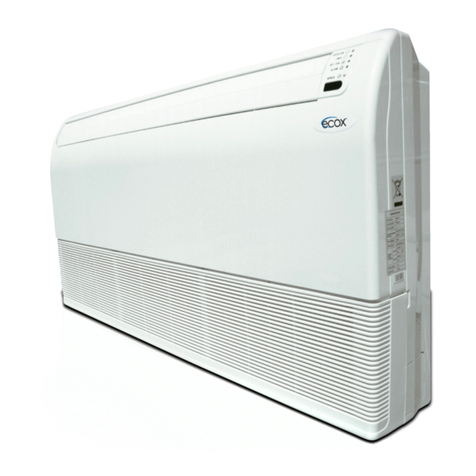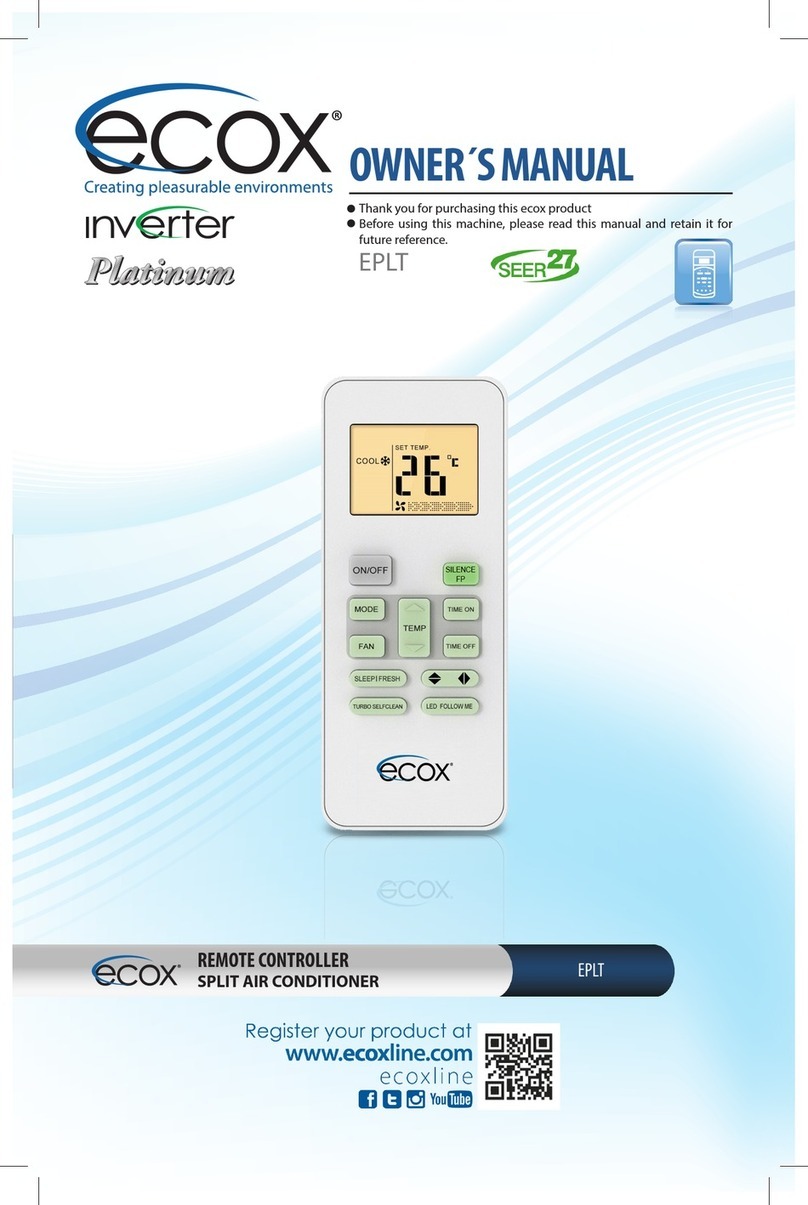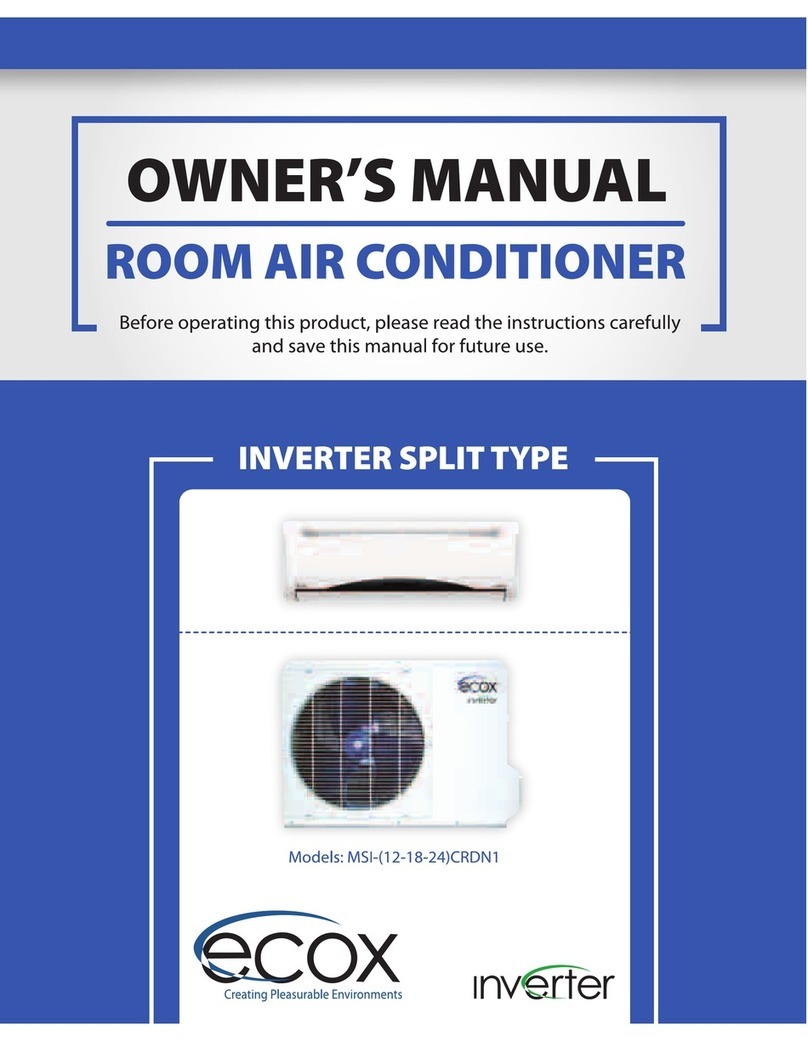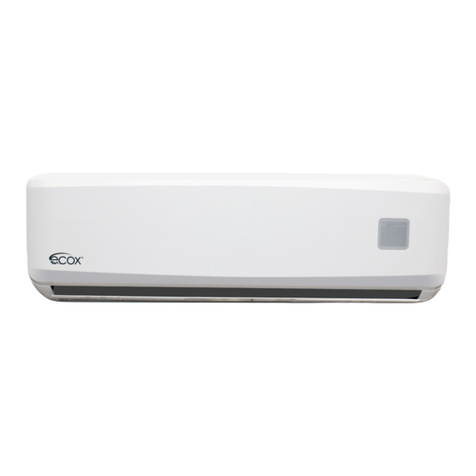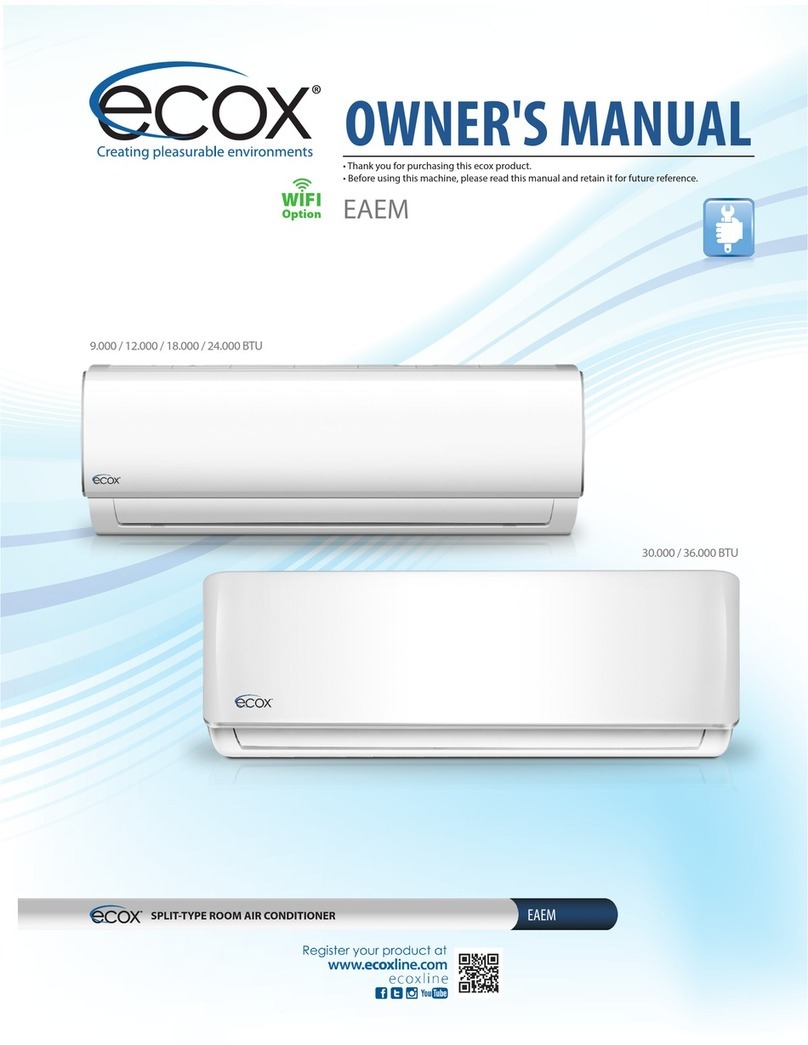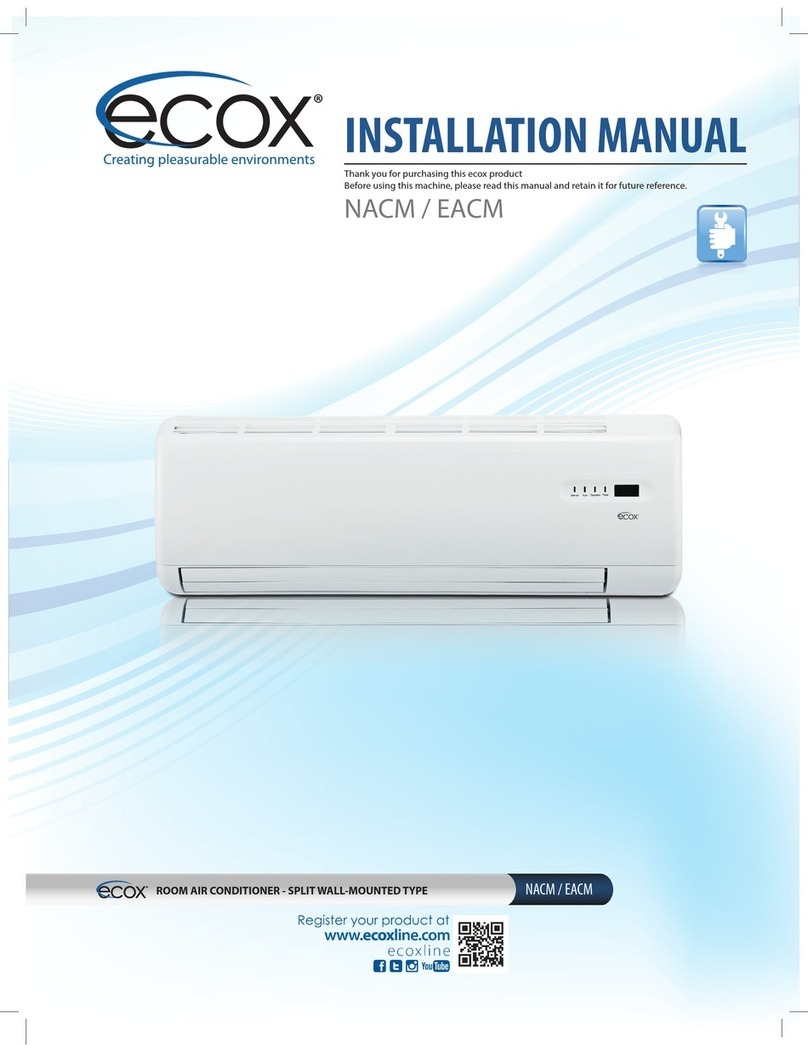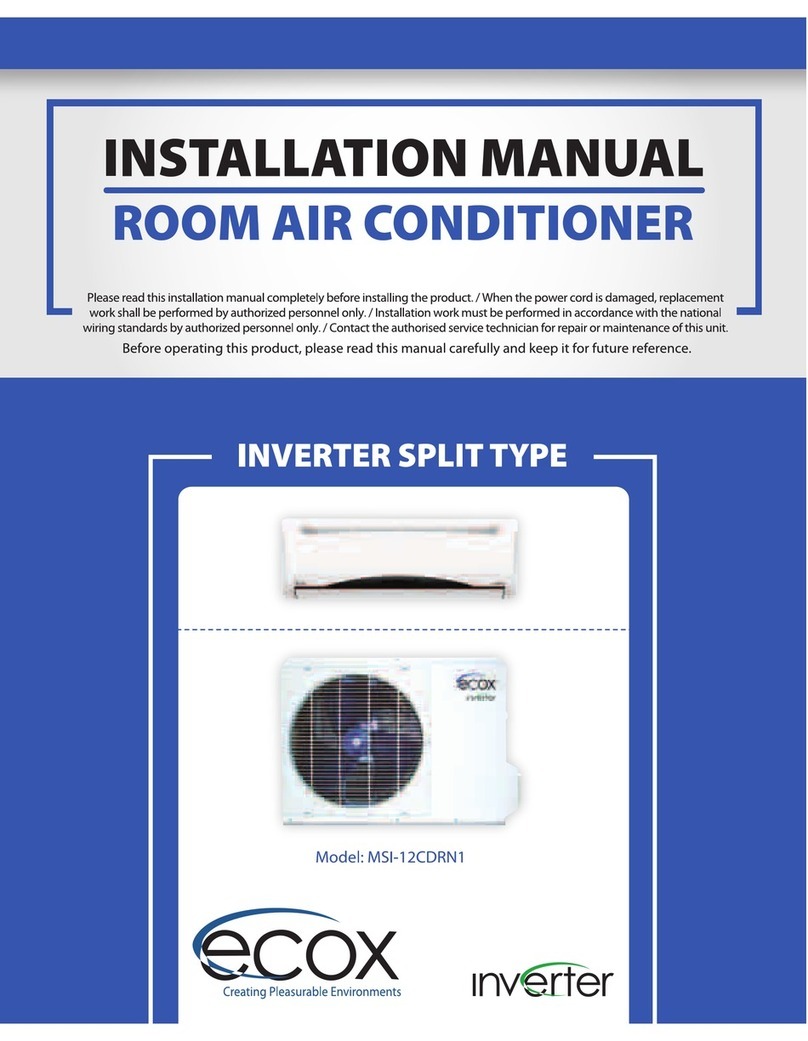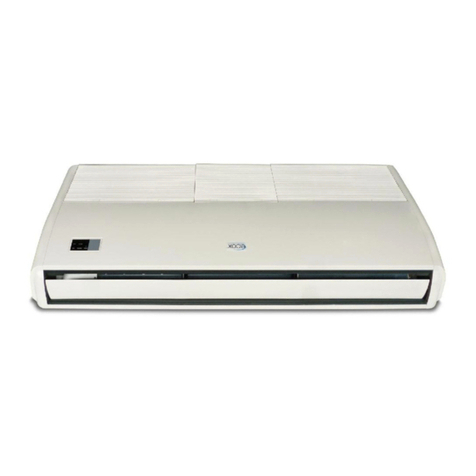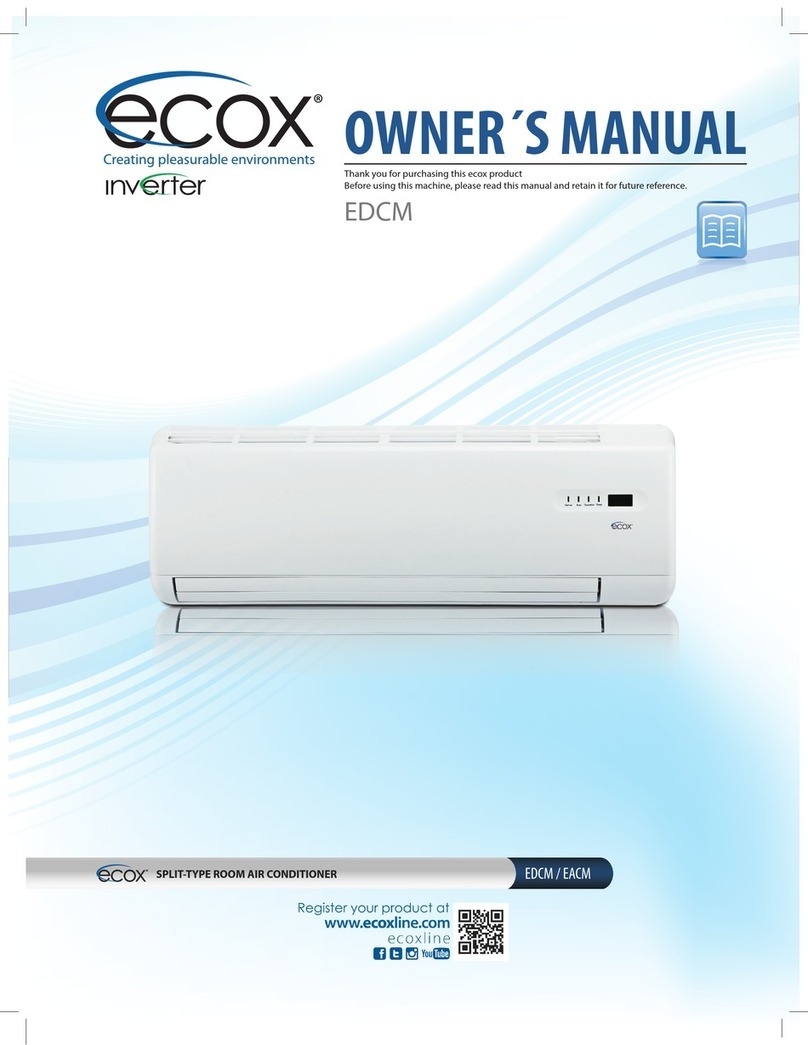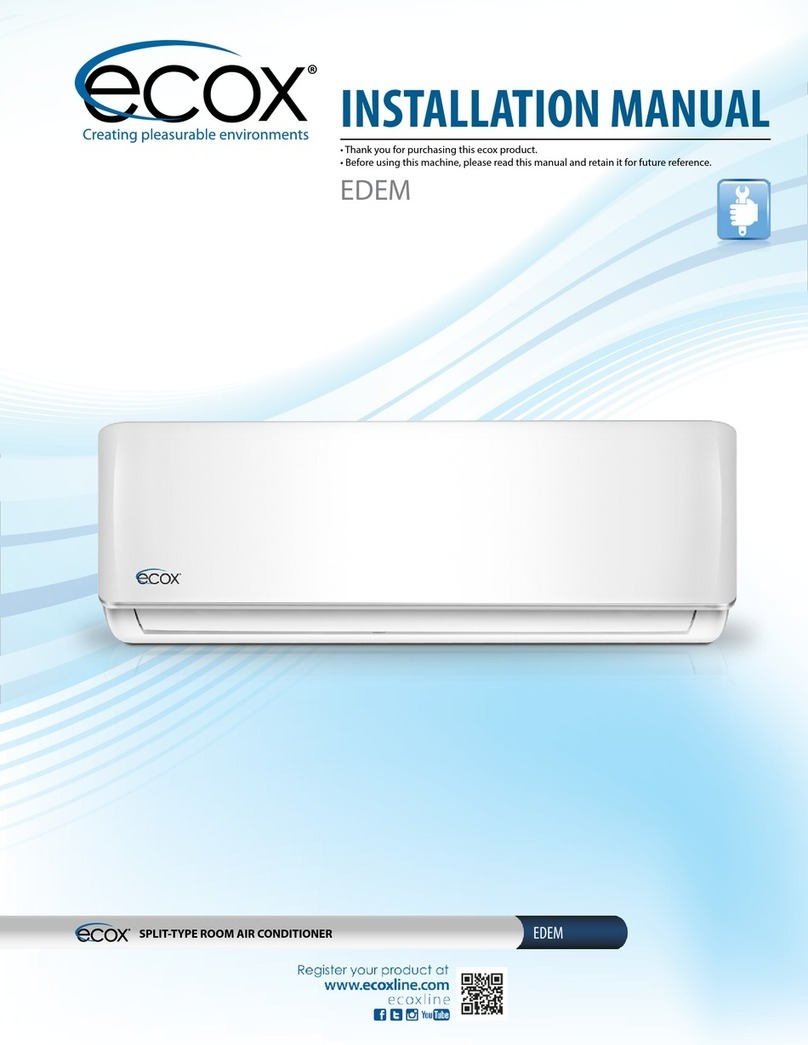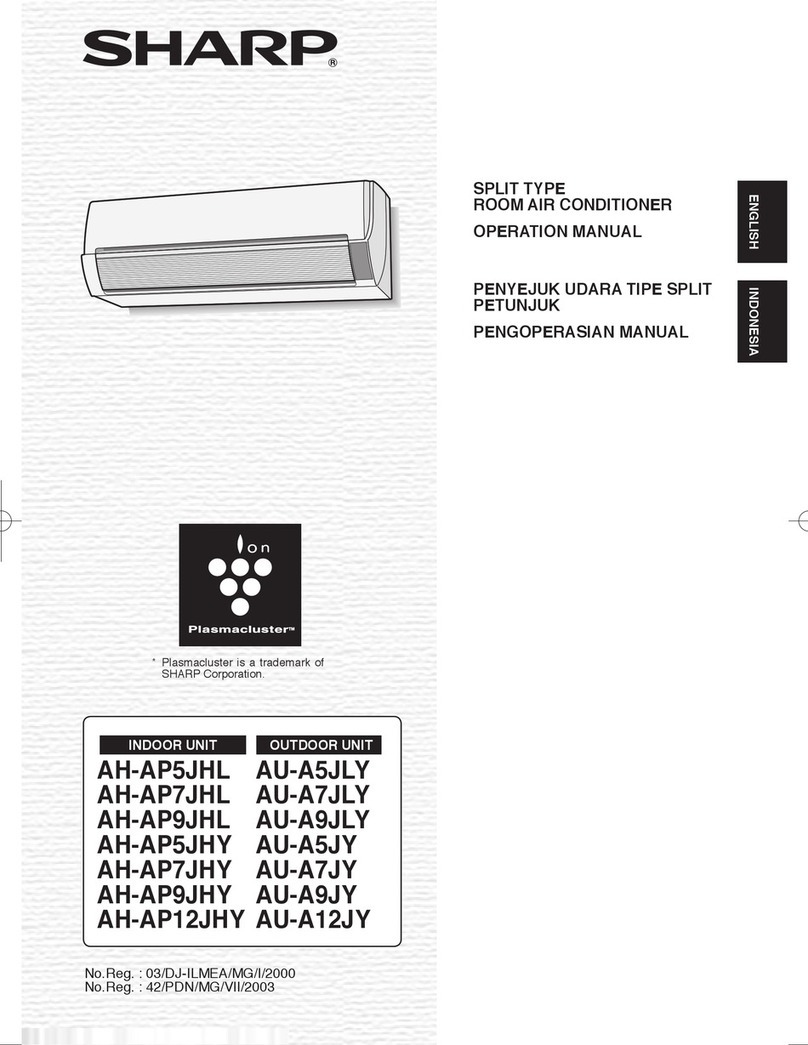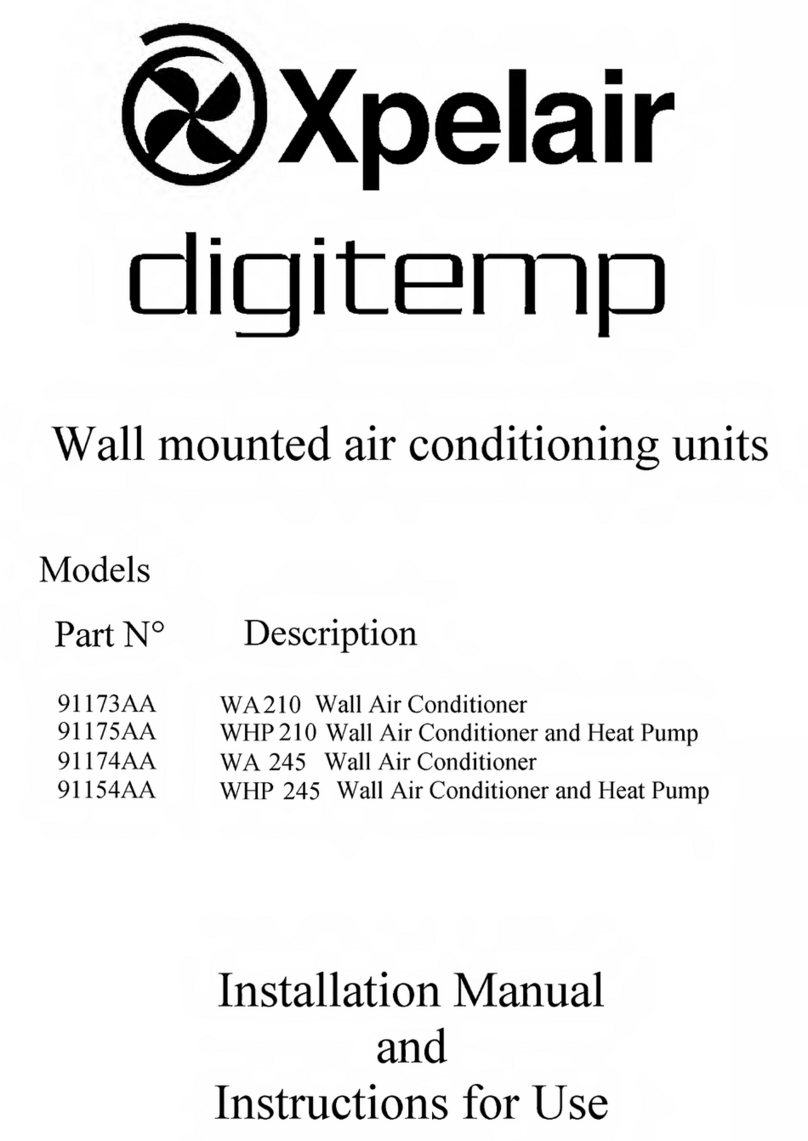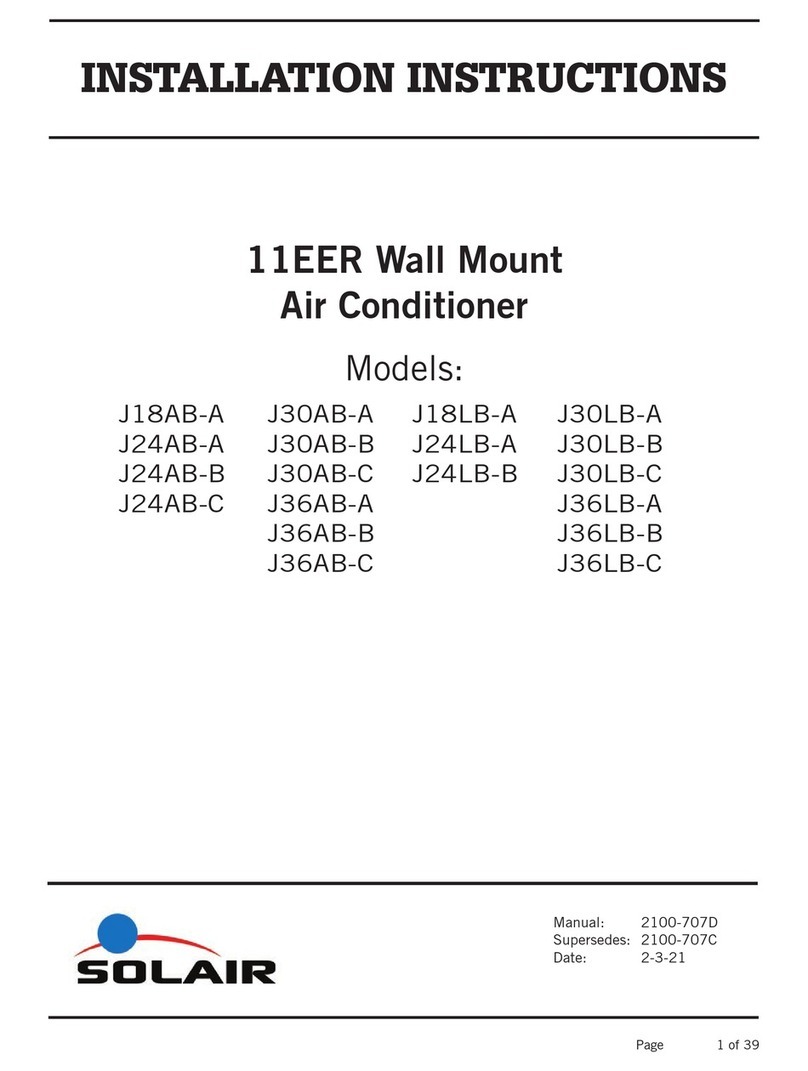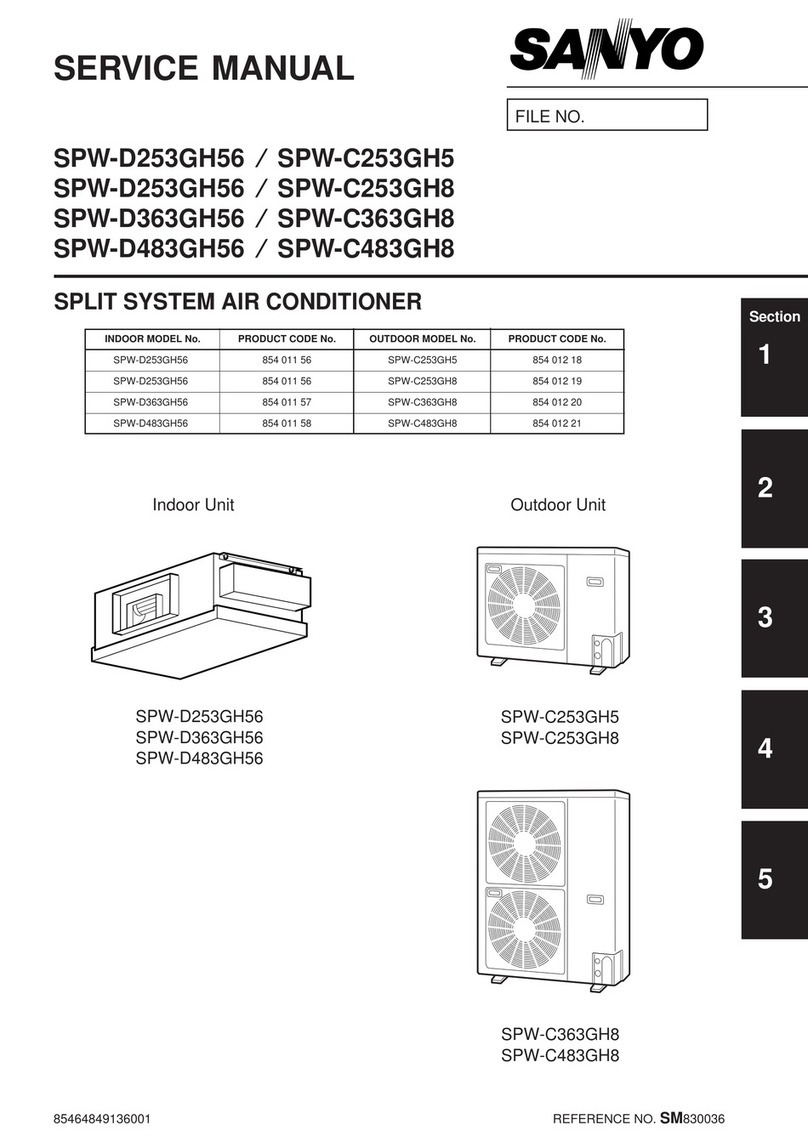Ecox EIHPTC Series User manual

CEILING FLOOR TYPE
• Thank you for purchasing this ecox product.
• Before using this machine, please read this manual and retain it for future reference.
OWNER´S MANUAL
EIHPTC
EIHPTC

2
EIHPTC CEILING FLOOR TYPE

3
EIHPTC
CEILING FLOOR TYPE
1
1
4
2
2
5
3
3
6
INDOOR UNIT
OUTDOOR UNIT
NOTE
All the pictures in this manual are for explanation purpose
only. They may be slightly dierent from the air conditioner you
purchased (depend on model). The actual shape shall prevail.
Air ow louver (at air outlet)
Air inlet (with air lter in it)
Installation part
Display panel
Remote control
Drain pipe
Connecting pipe
Air inlet
Air outlet
FIG. 1-1
OR
1
2
3
5
4
7
6
8
88
8
8
8
9
9
7

4
EIHPTC CEILING FLOOR TYPE
IMPORTANT SAFETY INFORMATION
TEMPORARY OPERATIONS
AIR CONDITIONER OPERATIONS AND PERFORMANCE
HINTS FOR ECONOMICAL OPERATION
ADJUSTING AIR FLOW DIRECTION
MAINTENANCE
FOLLOWING SYMPTOMS ARE NOT
AIR CONDITIONER MALFUNCTIONS
TROUBLESHOOTING
CONTENTS
IMPORTANT SAFETY INFORMATION1.
6
4
7
9
8
8
10
8
WARNING
WARNING
CAUTION
To prevent injury to the user or other people and property
damage, the following instructions must be followed.
Incorrect operation due to ignoring of instructions may
cause harm or property damage.
The safety precautions listed are divided into two categories.
In either case, important safety information is listed which
must be read.
Failure to observe a warning may result in death. The
appliance shall be installed in accordance with national wiring
regulations.
Ask your dealer for installation of the air conditioner.
Incomplete installation performed by yourself may result in a
water leakage, electric shock, and re.
Ask your dealer for improvement, repair, and maintenance.
Incomplete improvement, repair, and maintenance may result in a
water leakage, electric shock, and re.
Failure to observe a caution may result in injury or damage
to the equipment.
In order to avoid electric shock, re or injury, or if you detect any
abnormality such as smell of re, turn o the power supply and
call your dealer for instructions.
Never let the indoor unit or the remote control get wet.
It may cause an electric shock or a re.
Never press the button of the remote control with a hard,
pointed object.
The remote control may be damaged.
Never replace a fuse with that of wrong rated current or other
wires when a fuse blows out.
Use of wire or copper wire may cause the unit to break down or
cause a re.
It is not good for your health to expose your body to the air ow
for a long time.
Do not insert ngers, rods or other objects into the air inlet or
outlet.
When the fan is rotating at high speed, it will cause injury.
Never use a ammable spray such as hair spray, lacquer or paint
near the unit.
It may cause a re.
Never touch the air outlet or the horizontal blades while the
swing ap is in operation.
You may hurt your ngers and damage the unit.
Never put any objects into the air inlet or outlet.
Objects touching the fan at high speed can be dangerous.
Never inspect or service the unit by yourself.
Ask a qualied service person to perform this work.
Do not dispose this product as unsorted municipal waste.
Collection of such waste separately for special treatment
is necessary.
Contact you local government for information regarding the
available collection system.
If electrical appliances are disposed of in landlls or dumps,
hazardous substances can leak into the groundwater and drain
into the food chain, damaging your health and well-being.
To prevent refrigerant leak, contact your dealer.
When the system is installed and runs in a small room, it is required
to keep the concentration of the refrigerant if by any chance
coming out, below the limit. Otherwise, oxygen in the room may
be aected.
The refrigerant in the air conditioner is safe and normally does
not leak.
Refrigerant exposure to re or any type of heat source may cause
harmful gas.
Turn o any combustible heating devices, ventilate the room,
and contact the dealer where you purchased the unit.
Do not use the air conditioner until a service person conrms that
the portion where the refrigerant leaks is repaired.

5
EIHPTC
CEILING FLOOR TYPE
CAUTION
Do not use the air conditioner for other purposes.
In order to avoid any quality deterioration, do not use the unit for
cooling precision instruments, food, plants, animals or works of
art.
Before cleaning, be sure to stop the operation, turn the breaker
o or pull out the supply cord.
Otherwise, an electric shock and injury may result.
In order to avoid electric shock or re, make sure that an ground
leak detector is installed.
Be sure the air conditioner is grounded.
In order to avoid electric shock, make sure that the unit is grounded
and that the ground wire is not connected to gas or water pipe,
lightning conductor or telephone ground wire.
In order to avoid injury, do not remove the fan guard of the
outdoor unit.
Do not operate the air conditioner with a wet hand. An electric
shock may happen.
Do not touch the heat exchanger ns.
These ns are sharp and could result in cutting injuries.
Do not place items which might be damaged by moisture under
the indoor unit.
Condensation may form if the humidity is above 80%, the drain
outlet is blocked or the lter is polluted.
After a long use, check the unit stand and tting for damage.
If damaged, the unit may fall and result in injury.
To avoid oxygen deciency, ventilate the room suciently if
equipment with burner is used together with
the air conditioner.
Arrange the drain hose to ensure smooth drainage. Incomplete
drainage may cause wetting of the area.
Never touch the internal parts of the controller.
Do not remove the front panel. Some parts inside are dangerous to
touch, and may cause problems with the unit.
Never expose small children, plants or animals directly to
the air ow.
Adverse inuence to small children, animals and plants may occur.
Do not allow a child to mount on the outdoor unit or avoid
placing any object on it.
Falling or tumbling may result in injury.
Do not operate the air conditioner when using a room
fumigation - type insecticide.
Failure to observe could cause the chemicals to become deposited
in the unit, which could endanger the health of those who are
hypersensitive to chemicals.
Do not place appliances which produce open re in places
exposed to the air ow from the unit or under the indoor unit.
It may cause incomplete combustion or deformation of the unit
due to the heat.
Do not install the air conditioner at any place where ammable
gas may leak out.
If the gas leaks out and stays around the air conditioner, a re may
break out.
The appliance is not intended for use by young children or inrm
persons without supervision.
This appliance can be used by children aged from 8 years and
above and persons with reduced physical, sensory or mental
capabilities or lack of experience and knowledge if they have
been given supervision or instruction concerning use of the
appliance in a safe way and understand the hazards involved.
Children shall not play with the appliance.Cleaning and user
maintenance shall not be made by children without supervision.
This appliance is not intended for use by persons (including
children)withreducedphysical,sensoryormentalcapabilities,or
lack of experience and knowledge, unless they have been given
supervision or instruction concerning use of the appliance by a
person responsible for their safety.
Children should be supervised to ensure that they do not play
with the appliance.
If the supply cord is damaged, it must be replaced by the
manufacturer, its service agent or similarly qualied persons in
order to avoid a hazard.
Do not operate your air conditioner in a wet room such as a
bathroom or laundry room.

6
EIHPTC CEILING FLOOR TYPE
TEMPORARY OPERATIONS2.
The air conditioner consists of the indoor unit, the outdoor unit,
the connecting pipe and the remote control.
(See Fig.1)
Function indicators on indoor unit display panel.
FIG. 2-1
FIG. 2-1
FIG. 2-1
FIG. 2-1
FIG. 2-1
FIG. 2-1
FIG. 2-2
FIG. 2-3
DISPLAY PANEL
DISPLAY PANEL
DISPLAY PANEL
DISPLAY PANEL
DISPLAY PANEL
DISPLAY PANEL
DISPLAY PANEL
DISPLAY PANEL
MANUAL TIMER
ALARM
OPERATION
DEF./FAN
NOTE: DEF indicator (cooling and heating type) or FAN
indicator (cooling only type)
Infrared signal receiver
MANUAL
Infrared signal receiver
Timer indicator
Operation lamp Alarm
indicator
Temporary button
Temperature
indicator
PRE-DEF indicator (cooling and heating
type) or FAN indicator (cooling only type)
Infrared signal receiver
Timer indicator
Operation lamp
Alarm indicator
PRE-DEF indicator (cooling and heating
type) or FAN indicator (cooling only type)
MANUAL TIMER
ALARM
OPERATION
DEF./FAN
Infrared signal receiver
Temperature
indicator
NOTE: DEF indicator (cooling and heating type)
or FAN indicator (cooling only type)
TIMER ALARM
OPERATION DEF./FAN
Infrared signal receiver
NOTE: DEF indicator (cooling and heating type)
or FAN indicator (cooling only type)
MANUAL
Infrared signal receiver
NOTE: DEF indicator (cooling and heating type)
or FAN indicator (cooling only type)
MANUAL
Infrared signal receiver
Timer indicator
Operation lamp
Alarm
indicator
Temporary button
Temperature
indicator
PRE-DEF indicator (cooling and heating
type) or FAN indicator (cooling only type)
Infrared signal receiver
Timer indicator
Operation lamp
Alarm
indicator
Temporary button
Temperature
indicator
PRE-DEF indicator (cooling and heating
type) or FAN indicator (cooling only type)
TIMER ALARM
OPERATION DEF./FAN
MANUAL

7
EIHPTC
CEILING FLOOR TYPE
For inverter type, this switch is used for after-sales service
purpose only, the user should not push it.
For xed-frequency type, this function is used to operate the
unit temporarily in case you misplace the remote control or its
batteries are exhausted. Two modes including FORCED AUTO
and FORCED COOL can be selected through the TEMPORARY
BUTTON on the air-in grill control box of the indoor unit. Once
you push this button, the air conditioner will run in such order:
FORCED AUTO, FORCED COOL, OFF, and back to FORCED AUTO.
FORCED AUTO
The OPERATION lamp is lit, and the air conditioner will run
under FORCED AUTO mode. The remote control operation is
enabled to operate according to the received signal.
FORCED COOL
The OPERATION lamp ashes, the air conditioner will turn to
FORCED AUTO after it is enforced to cool with a FAN speed HIGH
for 30 minutes. The remote control operation is disabled.
OFF
The OPERATION lamp goes o. The air conditioner is OFF while
the remote control operation is enabled.
NOTE
NOTE
This manual does not include Remote Control Operations, see
the<<Remote Control Owner's manual>>
packed with the unit for details.
If air conditioner is used outside the above conditions, it may cause
the unit to function abnormally.
In high humidity areas, you may observe the presence of condensed
water on the surface of the unit. Close doors and windows to revert
the situation.
Optimum performance will be achieved within these operating
temperature range.
Three-minute protection feature
A protection feature prevents the air conditioner from being
activated for approximately 3 minutes when it restarts immedi-
ately after operation.
Power failure
Power failure during operation will stop the unit completely.
The OPERATION lamp on the indoor unit will start ashing
when power is restored.
To restart operation, push the ON/OFF button on the remote
control.
Lighting or wireless equipment operating nearby may cause
the unit to malfunction.
Disconnect the unit from the power and then connect the unit
to the power again. Push the ON/OFF button on the remote
control to restart operation.
Refrigerant Leakage Detection(optional):
With this new technology, when refrigerant leakage is detected
by the outdoor unit, EC (if applicable) will appear in the display
area and a indication lamp will ash in the LED.
Louver Angle Memory Function(optional):
For some models, the machine is special designed with louver
angle memory function. Power failure during operation or
pressing the ON/OFF button on the remote controller will stop
the unit completely. When the power restores or pressing the
ON/OFF button on the remote controller again, the unit restarts
automatically with the previous open angle of the horizontal
louver by the memory function. So we strongly recommend that
the open angle of the horizontal louver should not be set too small,
to prevent water condensation from the horizontal louver. Press the
Manual control button and the open angle of the horizontal louver
will be restored to the standard angle.
Use the system in the following temperature for safe and
eective operation. The Max operation temperature for the
air conditioner.(Cooling/Heating)
AIR CONDITIONER OPERATIONS AND PERFORMANCE3.
Cooling operation
Drying operation
Heating operation
(cooling only type without)
Mode
Temperature Outdoor
temperature
(for the models with low
temperature cooling system)
(for special tropical models)
(for special tropical models)
temperature
Room
18°C ~ 43°C / 64 °F~109°F
18°C ~ 52°C / 64 °F~126°F
-7°C ~ 43°C / 20 °F~109°F
-7°C ~ 24°C / 20 °F ~ 76°F
18°C ~ 43°C / 64 °F~109°F
18°C ~ 52°C / 64 °F~126°F
0°C ~ 30°C / 32 °F~86°F
17°C ~ 32°C
( 62 °F ~ 90°F)
17°C ~ 32°C
( 62 °F ~ 90°F)
1
1
2
3
2
3
0°C ~ 30°C / 32 °F~86°F
17°C ~ 32°C
( 62 °F ~ 90°F)
17°C ~ 32°C
( 62 °F ~ 90°F)
Cooling operation
Drying operation
Heating operation
(cooling only type without)
Mode
Temperature Outdoor
temperature
(for the models with low
temperature cooling system)
temperature
Room
0°C ~ 50°C / 32 °F~122°F
0°C ~ 50°C / 32 °F~122°F
-15°C ~ 50°C / 5 °F~122°F
-15°C ~ 24°C / 5 °F~76°F
TABLE. 3-1
TABLE. 3-1 (FOR INVERTER TYPE AIR CONDITIONER)

8
EIHPTC CEILING FLOOR TYPE
HINTS FOR ECONOMICAL OPERATION
MAINTENANCE
4.
6.
The following should be noticed to ensure an economical
operation. (Refer to corresponding chapter for details)
Adjust the air ow direction to avoid direct ow towards people.
Adjust the room temperature properly for a pleasurable
environment. Avoid excessive heating or cooling.
Avoid direct sunlight during cooling operations by using curtains
or blinds
Keep doors and windows closed. If the doors and windows remain
open, air will ow out of your room causing a decrease in the
cooling or heating eect.
Set the timer for the desired operating time.
Never place objects near the air inlet or the air outlet of the unit. It
may cause deterioration or stop the operation of the unit.
If you don't plan to use the unit for a long time, please disconnect
power and remove the batteries from the remote control. When
the power switch is connected, some energy will be consumed,
even if the air conditioner isn't in operation. So please disconnect
the power to save energy. switch the power on 12 hours before
you restart the unit to ensure a smooth operation.
Keep the indoor unit and remote control at least 1m away from
televisions, radios, stereos and other similar equipment. Failing to
do so may cause static or distorted pictures.
A dirty air lter will reduce cooling or heating eciency, please
clean it once every two weeks.
5.2 ADJUST THE VERTICAL LOUVER
When heating
Adjust the louver downwards. (vertically)
Auto-swing
Press SWING H button, the louver will swing left and right
automatically.
HINTS FOR ECONOMICAL OPERATION5.
5.1 ADJUST THE HORIZONTAL LOUVER
Auto-swing
Press SWING V button, the louver will swing up and down
automatically.
Manual Swing
Adjust the louver to achieve better cooling/heating eects
when cooling /heating.
When cooling
Adjust the louver horizontally.
FIG. 5-1
FIG. 5-2
FIG. 5-3
FIG. 5-4
CAUTION
Before you clean the air conditioner, be sure the power supply
is o.
Check if the wiring is not broken o or disconnected.
Use a dry cloth to wipe the indoor unit and remote controller.
A wet cloth may be used to clean the indoor unit if it is
very dirty.
Never use a damp cloth on the remote controller.
Do not use a chemically-treted duster for wiping or leave such
material on the unit for long.
It may damage or fade the surface of the unit.
Do not use benzine, thinner, polishing powder, or similar solvents
for cleaning.
These may cause the plastic surface to crack or deform.

9
EIHPTC
CEILING FLOOR TYPE
Maintenance after a long stop period
(eg. at the beginning of the season)
Check and remove everything that might be blocking inlet and
outlet vents of indoor units and outdoor units.
Clean air lters and casings of indoor units.
Refer to "Cleaning the air lter" for details on how to proceed
and make sure to install cleaned air lters back in the same
position.
Turn on the power at least 12 hours before operating the unit
in order to ensure smoother operation. As son as he power is
turned on, the remote control displays appear.
Maintenance before a long stop period
(eg. at the end of the season)
Let the indoor units run in fan only operation for about half a
day in order to dry the interior of the units.
Clean air lters and casings of indoor units. Refer to " Cleaning
the air lter" for details on how to proceed and make sure to
install cleaned air lters back in the same position.
Cleaning the air lter
The air lter can prevent the dust or other particles from going
inside. In case of blockage of the lter, the working eciency of
the air conditioner may greatly decrease.
Therefore, the lter must be cleaned once every two weeks
during long time usage.
If the air conditioner is installed in a dusty place, clean the the
air lter frequently.
If the accumulated dust is too heavy to be cleaned, please
replace the lter with a new one(replaceable air lter is an
optional tting).
3.2-10.5KW (10,000 - 36,000BTU/h)
Open the air intake with the screwdriver or similar object.
(Refer to Fig.6-1)
Take out the air lter. (Refer to Fig.6-2)
Clean the air lter with water or vacuum cleaner, then dry it in a
cool place.
Re-install the air lter in the reverse order of Fig.6-2.
14-16Kw (48,000 - 60,000Btu/h)
Directly pull out the air lter from air inlet as indicated in Fig.6-3.
Clean the air lter with water or vacuum cleaner, then dry it in a
cool place.
Re-install the air lter in the reverse order of Fig.6-3.
1
2
NOTE
The air-in side should face up when using vacuum cleaner.
The air-in side should face down when using water.
CAUTION
Do not dry out the air lter under direct sunshine or with heat.
Air Inlet
FIG. 6-1
FIG. 6-2
FIG. 6-3
Air filter
FOLLOWING SYMPTOMS ARE NOT AIR CONDITIONER TROUBLES
7.
Symptom 1: The system does not operate
The air conditioner does not start immediately after the ON/
OFF button on the romote control is pressed.
If the operation lamp lights, the system is in normal condition.
To prevent overloading of the compressor motor,
the air conditioner starts 3 minutes after it is turned ON.

10
EIHPTC CEILING FLOOR TYPE
TROUBLESHOOTING
8.
Symptom 2: Change into the fan mode during cooling mode
In order to prevent the indoor evaporator frosting, the
system will change into fan mode automatically, when low
temperatures are detected. Once the temperature of the tube
have raise, the cooling mode will be restored.
When the room temperature drops to the set temperature, the
compressor turns o and the indoor unit changes to fan mode;
when the temperature rises, the compressor starts again. It is
same in the heating mode.
Symptom 3: White mist comes out of a unit
Symptom 3.1: Indoor unit
When humidity is high during cooling operation, if the
indoor unit is dirty, the temperature distribution is uneven.
It is necessary to clean the interior of the indoor unit. Ask your
dealer for details on cleaning the unit. This operation requires a
qualied service person.
Symptom 3.2: Indoor unit, outdoor unit
When the system is changed over to heating operation after
defrost operation moisture generated by defrost becomes
steam and is exhausted.
Sptom 4: Noise of air conditioner coil
Symptom 4.1: Indoor unit
A continuous low "shah" sound is heard when the system is in
cooling operation or at a stop.
When the drain pump (optional accessories) is in operation,this
noise is heard.
A "pishi-pishi" squeaking sound is heard when the system
stops after heating operation.
Expansion and contraction of plastic parts caused by
temperature change make this noise.
Symptom 4.2: Indoor unit, outdoor unit
A continuous low hissing sound is heard when the system is
in operation.
This is the sound of refrigerant gas owing through both indoor
and outdoor units.
A hissing sound which is heard at the start or immediately
after stopping operation or defrost operation.
This is the noise of refrigerant caused by ow stop or ow
change.
Symptom 4.3: Outdoor unit
When the tone of operating noise changes. This noise is
caused by the change of frequency.
Symptom 5: Dust comes out of the unit
When the unit is used for the rst time in a long time. This is
because dust has accumulated in the unit.
Symptom 6: The units can give o odours
The unit can absorb the smell of rooms, furniture, cigarettes,
etc., and then emit it again.
Symptom 7: The outdoor unit fan does not spin.
During operation. The speed of the fan is controlled in order to
optimize product operation.
8.1 TROUBLES AND CAUSES OF AIR CONDITIONER MALFUNCTION
8.2 TROUBLES AND CAUSES OF REMOTE CONTROLLER
If one of the following malfunctions occur, stop operation,
shut o the power, and contact with your dealer.
The operation lamp is ashing rapidly (5Hz). The lamp is still
ashing rapidly after turn o the power and turn on again. (See
in Table 8-1a and Table 8-1b).
Remote control is giving the wrong signal or not working
properly.
A safety device such as a fuse or breaker frequently actuates.
Foreign objects or water enter the unit.
Water leaks from indoor unit.
Other malfunctions.
If the system does not operate properly or when the
above events are not evident, you may analyze the system
according to the following procedures. (see in table 8-2)
Before asking for servicing or repairing, check the following
points. (See in Table 8-3)

11
EIHPTC
CEILING FLOOR TYPE
MALFUNCT IO N & PROT EC TI ON D EF IN E DI SP LAY
LED4LED3LED2LED1
E8
E1
E2
E3
E4
E7
EE
Ed
F3
F4
In-O ut door unit CO MM. Chec ki ng
channel is abnor mal
R oom TEMP. sen so r ch ec king
ch anne l is abnor mal
Pipe TEMP. Sen so r ch ec ki ng
channe l is abnor mal(T2)
EPPR OM malfu nc ti on
Indoor fan motor speed out of control
Wate r- le ve l alar m malf un ct ion
Ou td oor malfu nc ti on
Indoor twins communication malfunction
Other malfunction of twins
2.5H ZF 0.5H Z
ALARMDEF.FANTIMEROPERATION
Pipe TEMP. Sen so r ch ec ki ng
channe l is abnor mal(T2B)
NO.
1
2
3
4
5
6
7
8
9
10
11 Refrigerant leakage detection malfunction EC
TABLE 8-1_A (APPLICABLE TO INVERTER AIR CONDITIONER TYPE ONLY)
Flashing atLight Flashing at

12
EIHPTC CEILING FLOOR TYPE
MALFUNCT IO N& PROT EC TI ON DE FI NE LED4LED3LED2LED1
E2
E3
E4
E6
E5
Flashing at 5H ZF lashin t1 H Z
ALARMDEF.FANTIMER
OPERATION
E7
E8
EC
Pump temperature sensor malfunction
Pipe temperature sensor checking channel
is abnormal
Water-level alarm malfunction
Refrigerant leakage detection malfunction
Room temperature sensor checking channel
is abnormal
EEPROM malfunction
Outdoor malfunction
Outdoor TEMP. sensor checking channel is
abnormal
In-Outdoor unit COMM. Checking
channel is abnormal E1
DC motor speed out of control
Outdoor unit low pressure error
Eb
Ed
NO.
Fl
TABLE 8-1_B (APPLICABLE TO FIXED-FREQUENCY AIR CONDITIONER ONLY)
ga
ga
Light
DI SP LAY

13
EIHPTC
CEILING FLOOR TYPE
TABLE 8-2
Solution
Clean the heat exchanger.
Clean the air filter.
Eliminate possible cause of blockage.
Close doors and windows.
The use of curtains or blinds is
recommended.
Reduce heat source.
AC cooling capacity reduces (normal).
Symptoms Causes
Unit does not start
Air flowing normally but not
cooling
Units start or stop frequently
Low cooling effect
Low heating effect
Power failure.
Power switch is off.
Fuse of power switch may have burned.
Batteries of remote controller exhausted
or other problem of controller.
Temperature is not set correctly.
Be in 3 minutes protection of
compressor.
Refrigerant is too little or too much.
Air or contaminated gas gas in the
refrigerating circuit.
Compressor is malfunctioning.
Voltage is too high or too low.
System circuit is blocked.
Wait for the comeback of power.
Switch on the power.
Replace the fuse.
Replace the batteries or check the
controller.
Set the temperature properly.
Wait.
Check leakage, and rightly recharge
refrigerant.
Vacuum and recharge refrigerant.
Maintenance or change compressor.
Install manostat.
Use heating device.
Close doors and windows.
Check leakage and rightly recharge
refrigerant.
Outdoor unit and indoor unit heat
exchanger is dirty.
The air filter is dirty.
Inlet/outlet of indoor/outdoor units is
blocked.
Doors and windows are open
Direct sunshine exposure.
Too much heat resource.
Outdoor temp. is too high.
Leakage of refrigerant or lack of
refrigerant.
Outdoor temperature is lower than 7 C .
Doors and windows not completely
closed.
Leakage of refrigerant or lack of
refrigerant.

14
EIHPTC CEILING FLOOR TYPE
TABLE 8-3
Symptoms Causes
The fan speed can not be
changed.
Check whether the MODE
indicated on the display is
"AUTO"
Check whether the MODE
indicated on the display is
"DRY"
When the automatic mode is
selected, the air conditioner will
automatically change the fan
speed.
When dry operation is selected,
the air conditioner automatically
changes the fan speed. The fan
speed can be selected during
"COOL" , "FAN ONLY",
and
"HEAT".
The remote control signal is
not transmitted even when
the ON/OFF button is pushed.
Check whether the batteries
in the remote controller are
exhausted.
The power supply is off.
No receiving tone sounds
from the indoor unit even
when the ON/OFF button is
pressed.
Check whether the signal
transmitter of the remote
controller is properly directed
to the infrared signal receiver
of the indoor unit when the
ON/OFF button is pressed.
Directly transmit the signal transmitter
of the remote controller to the infrared
signal receiver of the indoor unit, and
then repeatly push the ON/OFF button
twice.
The indication on the display
disappears after a lapse of
time.
Check whether the timer
operation has come to an
end when the TIMER OFF
is indicated on the display.
The air conditioner operation will
stop to the set time.
The TIMER ON indicator
goes off after a lapse of
certain time.
Check whether the timer
operation is started when
the TIMER ON is indicated
on the display.
Up to the set time, the air conditioner
will automatically start and the
appropriate indicator will go off.
The TEMP. indicator does
not come on.
Check whether the MODE
indicated on the display is
FAN ONLY
The temperature cannot be set during
FAN mode.
Solution

15
EIHPTC
CEILING FLOOR TYPE

This manual suits for next models
2
Table of contents
Other Ecox Air Conditioner manuals
Popular Air Conditioner manuals by other brands

COUGAR
COUGAR MHP120 quick guide
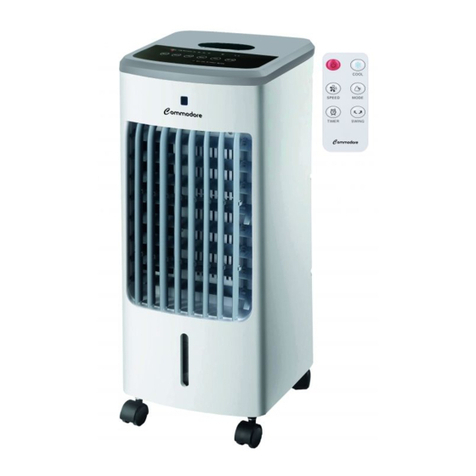
Commodore
Commodore CM1014 instruction manual

Mitsubishi Electric
Mitsubishi Electric PKFY R2 Series Operation manual
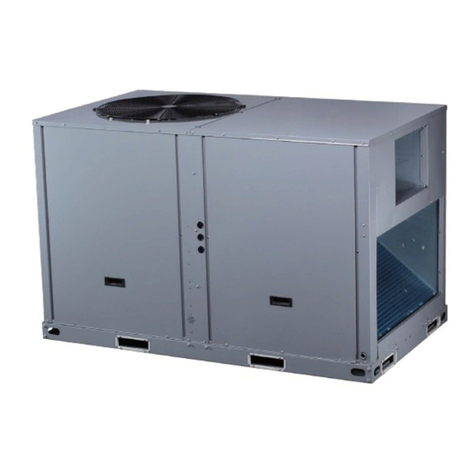
Midea
Midea MRCT-075CWN1-D(C) Technical & service manual
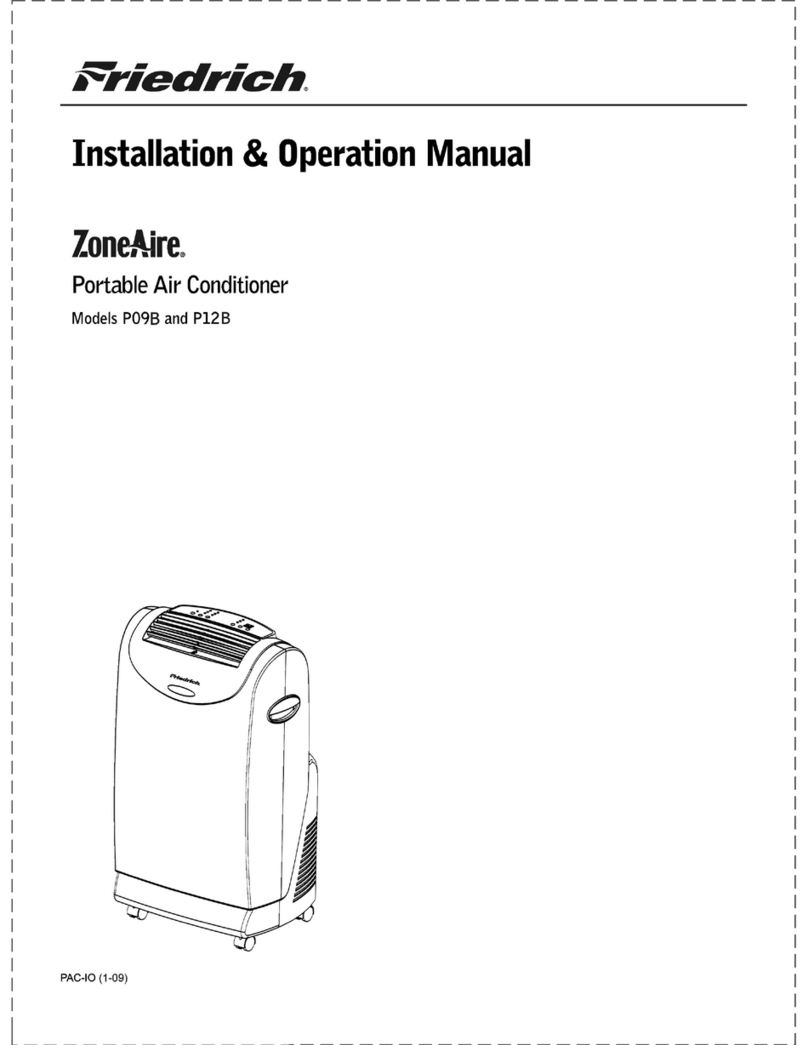
Friedrich
Friedrich ZoneAire P09B Installation & operation manual
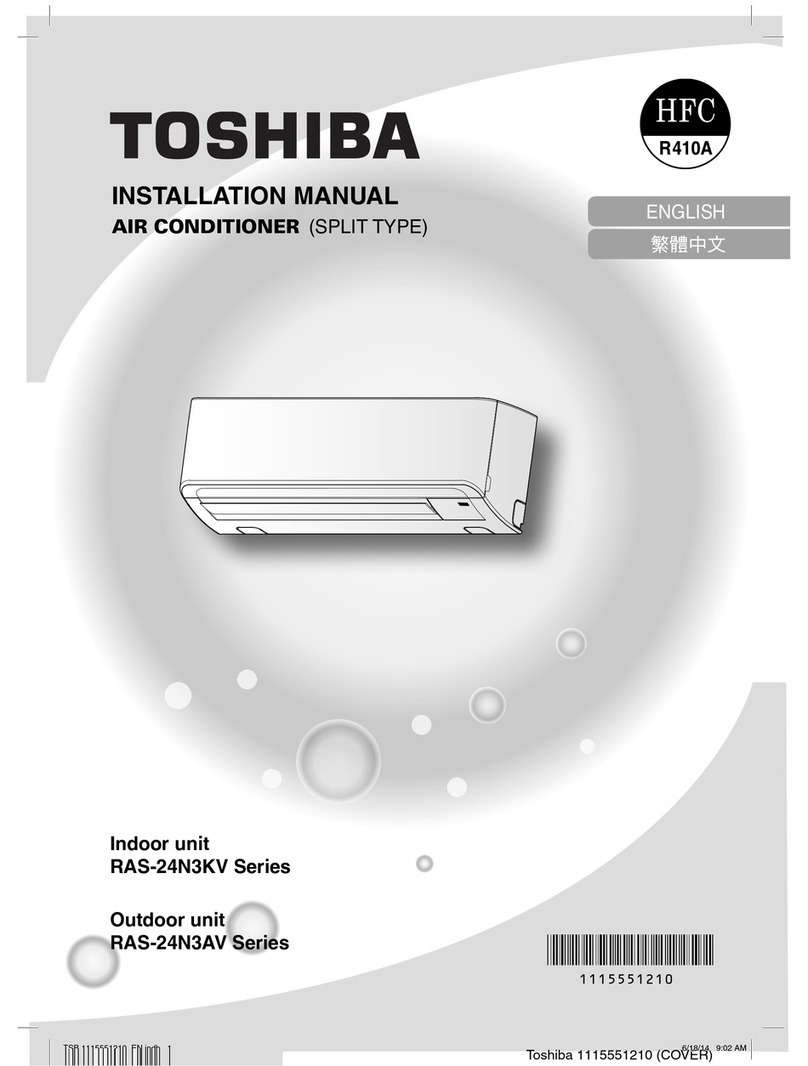
Toshiba
Toshiba RAS-24N3KV Series installation manual

Samsung
Samsung HC175TGZA Owner's instructions
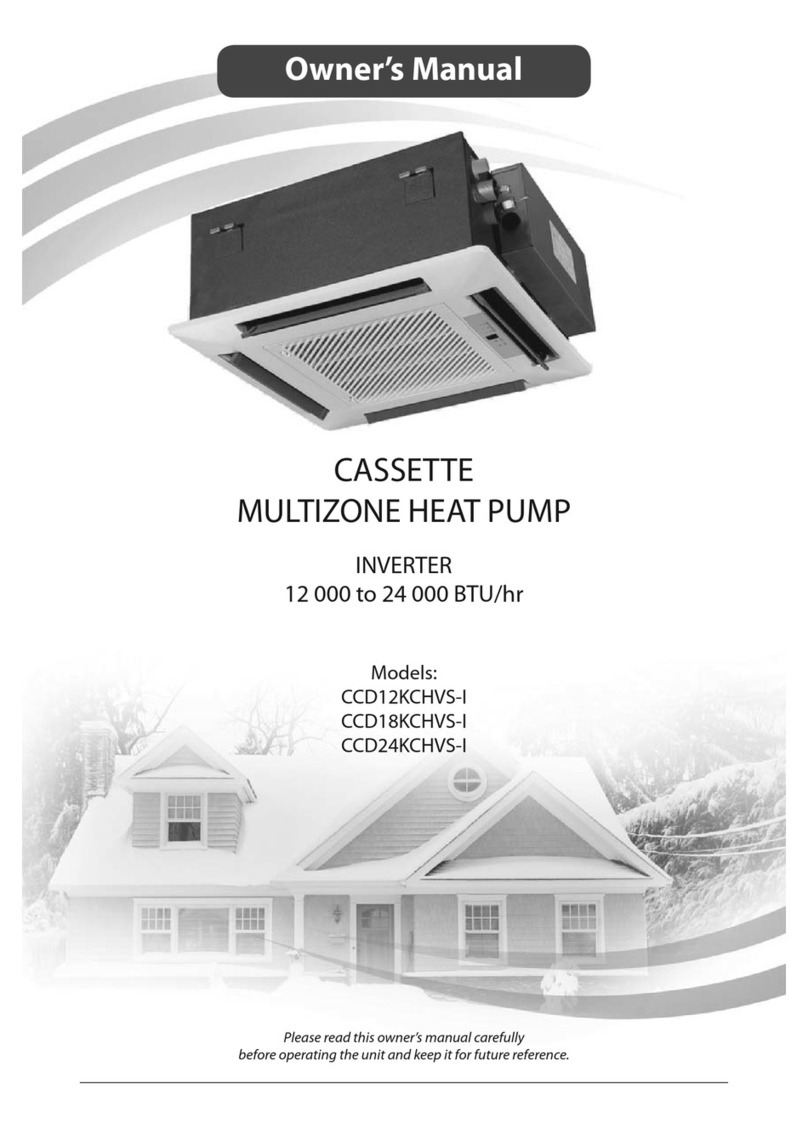
Ouellet
Ouellet CCD12KCHVS-I owner's manual
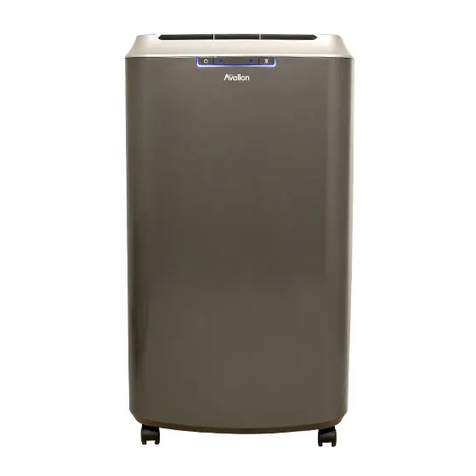
Avallon
Avallon APAC140C user guide

Lennox
Lennox KVCK 22E Installation, operation & maintenance manual

GEAppliances
GEAppliances AKV10 Owner's manual and installation instructions
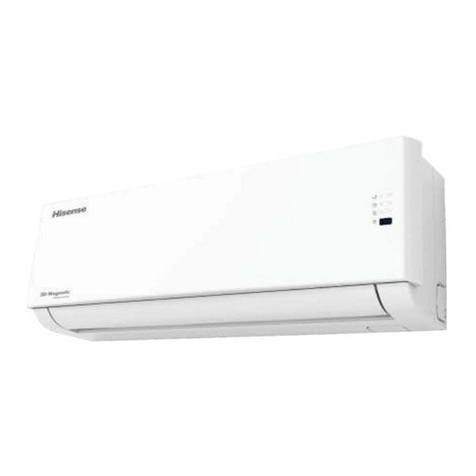
Hisense
Hisense AMS-07UR4SNZA3 Service manual
